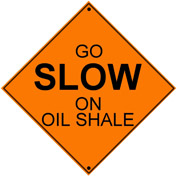Oil Shale in Western Colorado
BLM’s Programmatic Environmental Impact Statement on Tar Sands & Oil Shale:
Comment by May 4!
When oil shale is mentioned on the Western Slope of Colorado, it is discussed as a boondoggle that brought our economy to its knees. The day that Exxon closed down its oil shale operations and sent home over 2,000 workers — May 2, 1982 — is still referred to as Black Sunday. Extracting oil out of rock proved to be too technologically challenging and too expensive to pursue.
Now, over 20 years later, Congress tells us that everything has changed. With surging oil prices, suddenly oil shale is being touted as a way for the U.S. to achieve energy independence. The Energy Policy Act of 2005 put the Bureau of Land management (BLM) on a path to commercially lease oil shale reserves as early as 2008 — despite the fact that no economically viable technology to extract these resources has yet been proven. Concerns are many-fold:
- Oil shale development is a water buffalo. Mining and retorting oil shale takes two to three barrels of water to produce just one barrel of oil in this, one of the West’s driest areas.
- With new industry comes significant numbers of people and increased demands on our government, our roads, our schools, and our hospitals.
- The mining and processing of shale itself produces numerous toxic pollutants, such as sulfur dioxide, carbon monoxide, ozone, and particulates. The power plants required for in-situ development alone would release ten million tons of greenhouse gases.
- Turning rocks to oil also requires massive amounts of energy. Even just a 100,000 barrel-per-day oil shale operation would require 1,200 megawatts of electricity — requiring a new power plant as large as any currently operating in Colorado.
 Western Colorado Congress believes that proposed commercial leasing regulations should:
Western Colorado Congress believes that proposed commercial leasing regulations should:
- Adopt a staged approach, whereby commercial leasing will not take place until after successful technologies have been shown either on federal Research, Development and Demonstration (RD&D) leases or on private land.
- Adopt a schedule and scale that meets with the approval of local communities.
- Include measures to discourage speculative leasing, such as establishing minimum production levels.
- Establish the size of the leases in a commercial leasing program based on the carrying capacity of the land, as set out in applicable Management Plans.
- Require extensive baseline monitoring as well as mine or in-situ construction, operational, and post-operational monitoring to provide accurate information about the effects commercial shale development operations are having on the environment and local communities.
- Where federal shale resources underlie land managed by another agency, require consultation and written consent to leasing from the surface-managing agency before federal oil shale may be leased.
- Contain reclamation standards and ensure that companies post adequate bonds for long-term protection of resources.
On February 15, 2011, US Department of the Interior (DOI), WCC and 12 other conservation groups settled two pending lawsuits, suspending litigation so DOI can review oil shale policies adopted by the previous administration.
The suits contested regulations for proposed commercial leasing, and the decision to open commercial leasing of 2 million acres of federal lands in Colorado, Utah and Wyoming. Settlement does not affect the more than 200,000 acres of privately-held oil shale lands or the extensive state oil shale lands in Utah.
The agreement provides that he BLM will publish final oil shale leasing regulations by November 18, 2012.
